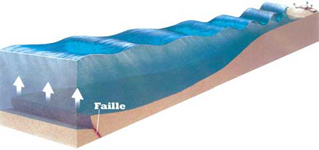Examples of French warning systems
PDF
In response to the 2004 disaster, France established its warning centre for the Mediterranean and North-East Atlantic, CENALT (Centre national d’Alerte aux Tsunamis: www.info-tsunami.fr), led by the Ministries of the Interior and Ecological and Solidarity Transition. The centre is managed by the CEA, in partnership with the French Navy’s Hydrographic and Oceanographic Service (Shom), responsible for sea level monitoring in France, and the National Centre for Scientific Research (CNRS), responsible for seismological networks.
The mandate of CENALT is to transmit alert messages to the Centre Opérationnel de Gestion Interministérielle des Crises (COGIC) in less than 15 minutes following the earthquake. This mission relies on an operator on duty 24 hours a day, 7 days a week. Messages are established very quickly on the basis of seismic parameters. They include the expected arrival times in the various French departments, and the alert level (yellow, orange or red) established on the basis of geophysical criteria. CENALT is one of the 11 UNESCO centres providing tsunami warnings.




